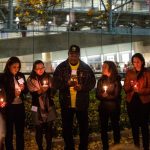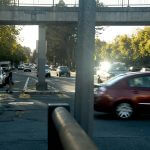SFMTA: Act now to prevent a tragic surge in traffic crashes
Walk San Francisco, on behalf of its members and everyone who walks, sent this letter to the San Francisco Municipal Transportation Agency (SFMTA) Director of Transportation, Jeffrey Tumlin on May 14. We hope you’ll join us in urging action for safe streets; you can send an email with similar language (feel free to personalize).
Dear Director Tumlin:
Thank you. We are deeply grateful for all the ways you have responded creatively and nimbly during this unprecedented time. From keeping transit moving for all who depend on it, to helping seniors and people with disabilities through the Essential Trip Card, to launching the Slow Streets program, you have kept a constant eye toward health, safety, and equity.
It is in that same vein that we raise an imminent threat, especially given the number of people walking and biking for transportation and exercise. Vehicle traffic is beginning to rise after a dramatic 60% reduction during shelter-in-place. And traffic could ultimately far exceed previous levels as fewer people use public transportation, according to the recent Vanderbilt University study.
Without immediate action by the SFMTA, we will soon see a tragic surge in severe and fatal traffic crashes in San Francisco, especially among our most vulnerable. And the City’s Vision Zero goal will slip out of sight.
San Francisco has experienced enough heartbreak and loss due to Covid-19. We cannot let our city once again be a place where an average of 30 people are killed and nearly 600 people severely injured in traffic crashes each year. The solutions exist to prevent these devastating traffic crashes. Pursuing these solutions with the utmost urgency is the only way forward.
That’s why, on behalf of our members and everyone who walks in San Francisco, we ask SFMTA to immediately implement the following fast, affordable, and proven solutions to make all of us safer on our streets now. These life-saving solutions are aimed at the top five causes of traffic crashes in San Francisco.
1. Put Policies in Place ASAP to Keep People Safe in the Crosswalk
There are many straightforward policy solutions that will go a long way in addressing the three biggest threats to people in the crosswalk: drivers running stop signs, failing to yield while turning, and failing to yield to a pedestrian in the crosswalk.
- We urge SFMTA to pass and implement a comprehensive ‘no turn on red’ policy for the 130 miles of streets on the high-injury network in 2020. No turn on red gives people and drivers each their own dedicated time to go, preventing conflict in the crosswalk. New York City and Washington DC have implemented widespread ‘no turn on red’ policies.
- We urge SFMTA to immediately bring left turn calming to all eligible intersections on the high-injury network in 2020. Left turn calming increases pedestrian safety with strategically placed rubber bumpers in an intersection, which reduces the speed that drivers take the turn plus gives drivers better visibility of the crosswalk. At intersections in New York City with left turn calming, pedestrian injuries have decreased by 20% (and they are now installed at 300+ intersections).
- We urge SFMTA to complete daylighting on the entire high-injury network, including painted pedestrian safety zones and posts, in 2020. Daylighting reduces crashes by creating clear sight lines for both drivers and pedestrians at intersections. We ask that daylighting the complete high-injury network be fast-tracked, with painted safety zones and soft-hit posts (or bike parking corrals) added so these safety zones aren’t used for short-term illegal parking.
2. Expand Red Light Cameras to 10 Additional Dangerous Intersections This Year
We urge the SFMTA to add red light cameras to at least 10 high-injury intersections in 2020. The crashes that result from red light running are likely to be severe or fatal because they are “right-angle” crashes (i.e. the victim is broadsided). Yet San Francisco currently has red light cameras at only 13 intersections.
New York City’s red light camera program has seen an 84% decline in severe injuries from right-angle crashes at its over 150 signalized intersections. San Francisco is underutilizing a highly-effective technological solution to calm our streets, plus send a message that aggressive driving has no place in San Francisco. And red light cameras work all day and night, freeing police resources to focus on other enforcement needs.
3. Start Tackling Speed, the #1 Cause of Severe and Fatal Crashes
We urge SFMTA to install an extensive network of low-cost dynamic speed radar signs in 2020, with a focus on high-injury streets to collect speed data and begin to curb speeding.
Speed is the number one factor in severe and fatal crashes in San Francisco. But long-term solutions including lower speed limits and speed safety cameras will take time (and state legislation) to happen.
Speed radar signs will provide accurate and necessary data for more targeted traffic enforcement now, as well as better management of speed limits and deployment of speed safety cameras in the future. Speed radar signs also reduce speeds by an average of 5 MPH, which is meaningful in terms of pedestrian crash survival rates.
There’s no time to waste in moving forward with this suite of practical solutions for safe streets. Lives are at stake, and Walk San Francisco and our members stand at the ready to support you in any way we can.
Thank you for your leadership.
Sincerely,
Jodie Medeiros, Executive Director
CC:
SFMTA Board of Directors
Livable Streets Director, Tom Maguire




